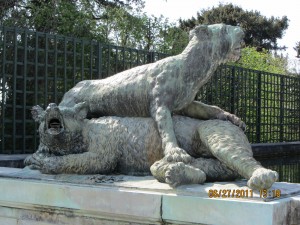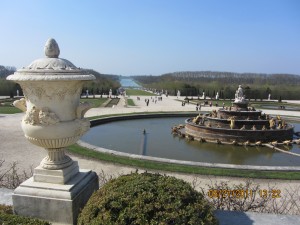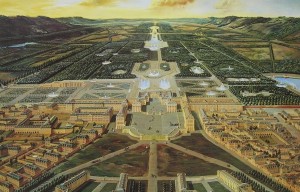 Thinking we had escaped the claustrophobia of the plane, we pushed off from the Charles De Gaulle car rental lot, a hot pit sunk between entrance and exit ramps of the A-11 expressway, and drove south west toward Versailles under unfamiliar signs and in heavy traffic. I could feel myself at the edge of being stupid with fatigue, but I had to be alert, and Patti as well, to keep her superb navigating sense focused on taking us out of all the confusion. I avoided cracking up our wonderful car, we avoided winding up in Belgium, and we smiled finally when we struck signs that would take us away from the ordinary technological maw of the airport and into the France of our expectations – Parc de Saint Cloud, and Marnes la Coquette, Maris the Coquette. Who else names villages after a woman who flirts like a young girl? Village gave way to countryside and then to the town of Versailles and then to the Palace. No photo can do justice to the three-dimensional vastness of the Palace and Gardens. Here as shown between 1669-1685.
Thinking we had escaped the claustrophobia of the plane, we pushed off from the Charles De Gaulle car rental lot, a hot pit sunk between entrance and exit ramps of the A-11 expressway, and drove south west toward Versailles under unfamiliar signs and in heavy traffic. I could feel myself at the edge of being stupid with fatigue, but I had to be alert, and Patti as well, to keep her superb navigating sense focused on taking us out of all the confusion. I avoided cracking up our wonderful car, we avoided winding up in Belgium, and we smiled finally when we struck signs that would take us away from the ordinary technological maw of the airport and into the France of our expectations – Parc de Saint Cloud, and Marnes la Coquette, Maris the Coquette. Who else names villages after a woman who flirts like a young girl? Village gave way to countryside and then to the town of Versailles and then to the Palace. No photo can do justice to the three-dimensional vastness of the Palace and Gardens. Here as shown between 1669-1685.
Their central axis runs from the gilded Palace gate to the end of the Grand Canal where it is lost in the horizon line. The Grand Canal alone is one mile in length. On foot, the unobstructed sky and sight lines create an illusion that only boundless wealth can foster; even now they make it seem as if all the rest of the world must be focused on this one place — in the levels dropping down from gardens to fountains and tree lined boulevards and to the long Canal where Louis XIV, the “Sun King,” could drift in a gondola with his mistress of the moment and look up to his Palace and believe that he too was the center of the center of the world, one he had created out of a hunting lodge.  After he readied himself for the day or for sleep, during the Royal Rising and Going to Sleep Ceremonies*, he could step from his bedroom into the Hall of Mirrors and look west down the canal or step into the hallway to the east and look into the Courtyard, and down along the Grand Boulevard. Inside of a few steps, he could survey the dominant line of Versailles design, his bedroom at its center. The general plan of Versailles is all “vast, straight, linear, simple, formal, strong, and generous, a pattern that speaks of power.” **
After he readied himself for the day or for sleep, during the Royal Rising and Going to Sleep Ceremonies*, he could step from his bedroom into the Hall of Mirrors and look west down the canal or step into the hallway to the east and look into the Courtyard, and down along the Grand Boulevard. Inside of a few steps, he could survey the dominant line of Versailles design, his bedroom at its center. The general plan of Versailles is all “vast, straight, linear, simple, formal, strong, and generous, a pattern that speaks of power.” ** 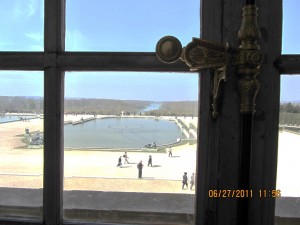
Versailles began as a hunting lodge for the nobility and eventually Kings. Don’t imagine any kind of fair chance for the prey. The countryside was stocked, country people were assembled to beat all manner of wild animals toward the hunting parties and they were slaughtered. this style of hunting was blood sport for the aristocracy.
For fifty years the Sun King revised and added to the Palace and its grounds. Close to 40,000 men and women labored to build it in land that was once a swamp. Many died from malaria. Historians cannot agree upon how much all of it cost except this – we would measure it in the tens of billions of dollars. Some of that money paid artists and artisans of every kind to work all their lives to create measures of beauty that would meet the gaze of Louis and be approved. One has to wonder what they spoke of when they gathered away from the supervision of their overlords – they had food and shelter and work at a time when such necessities were never guaranteed. They had the satisfaction of making beautiful things, of seeing their imagined designs rendered into paintings, tapestries, mirrors, stonework, choral compositions, clothes, linens, sculptures, fountains, feats of engineering, and beds of flowers and shrubs that swirled into arcane, striking geometries. 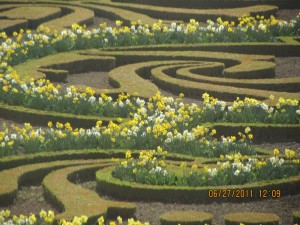 However, they also saw the gathered nobility of France up close whom Louis had summoned by the hundreds so he could keep them under watch and control. The artists and other servants, 5000 of them, watched their affairs, and were privy to their jealousies and cruel stratagems by which they hoped to grow closer to the “Sun.” What a place for gossip! What a place for stratums of spies – entire geological gradations! The servants knew about the nobility’s habit of pissing behind and into the plants in the hallways which carried the stink for weeks. They knew of those who were being cuckolded and those who wept behind closed doors. Servants see everything and carry tales. They saw the weaknesses of the elite in all of their particulars. One wonders if the seeds of the Revolution were not planted in the over familiarity of the workers with those who so ungraciously depended upon their work.
However, they also saw the gathered nobility of France up close whom Louis had summoned by the hundreds so he could keep them under watch and control. The artists and other servants, 5000 of them, watched their affairs, and were privy to their jealousies and cruel stratagems by which they hoped to grow closer to the “Sun.” What a place for gossip! What a place for stratums of spies – entire geological gradations! The servants knew about the nobility’s habit of pissing behind and into the plants in the hallways which carried the stink for weeks. They knew of those who were being cuckolded and those who wept behind closed doors. Servants see everything and carry tales. They saw the weaknesses of the elite in all of their particulars. One wonders if the seeds of the Revolution were not planted in the over familiarity of the workers with those who so ungraciously depended upon their work. 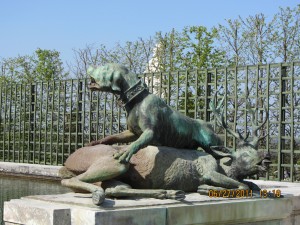
The Palace is meant to awe and now does so in its size and sweep, but it must have been a nightmare in which to live – cold in winter with no sense of privacy and vast distances to traverse. For the nobility forced to reside there, the everyday theater of a Court existence must have become exhausting. What was there to do but dress, seduce and be seduced, play games, gossip and plot, perform, deceive, hunt, eat, drink, and grovel? No purpose, little meaning, one day blurring into the next. Then, perhaps seeking relief out of doors in flowers and birdsong, they stepped into the boulevards almost wholly open to the sun and enormous in their width and entered yet another realm of theater, if one definition of theater means to be seen on a stage and act a role. Their only escape from their roles would have come with sleep, as long as they were alone.
It was hot the afternoon we walked our miles down and through the levels of Gardens. In the summer, the sun must broil the tourists on the white crushed stone of the avenues; it must have done the same to the nobility and been much worse – they would have been dressed in layer upon layer of silk and corsets and wigs and hats, but if Louis was to promenade , then they would want to be near. What a daily existence – to be trapped by their status into being utterly dependent upon the man who saw no difference between the State and his own body. Whether Louis ever said “”L’État, c’est moi” (I am the state), he lived his life in its certainty.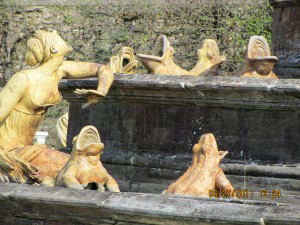
Still, I felt myself being seduced by the harmony created by the designer of the gardens and the vistas. Water, sky, grass, trees, flowers, space and all of it, for someone who loves the sky and distances of the American West, immensely pleasing, but the artificiality of it is also omnipresent and oppressive. 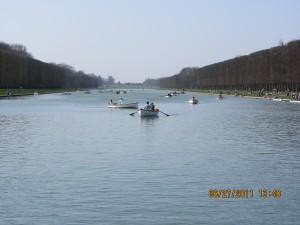 Every effect over which your eyes can sweep was designed to create a sense of wholeness, but a masterpiece of an alternate reality so at odds with the everyday life of the peasantry and merchants upon which all of it depended that its arrogance is breathtaking.
Every effect over which your eyes can sweep was designed to create a sense of wholeness, but a masterpiece of an alternate reality so at odds with the everyday life of the peasantry and merchants upon which all of it depended that its arrogance is breathtaking.
However, one sly detail from one enormous painting remains with me, perhaps a grace note of its creator’s ironic sensibility. I did not write down its title or the name of the artist. It takes up an entire wall in one gilded and draped room of the Palace. In the monumental display of hubris that is Versailles, the image of this one woman is so mischievous and mysterious, so direct and sympathetically human, that it made me laugh in relief. I wanted to know her. All her bone and blood and heart shows in her eyes and her defiant gaze. She seems like someone grown tired of looking at little gods.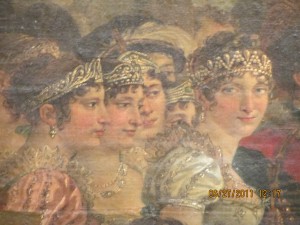
*Never underestimate the groveling required to a King in an absolute monarchy – nobles and those who wished favors pushed themselves into Louis’ bedroom and bathroom to watch him be dressed, shaved, washed, do his business and later undress, etc., all in the hope that he might deign to listen to requests or even, miracle des miracles, grant them. Sometimes as many as one hundred were in attendance.
**Getting Back Into Place by Edward Casey Page 161.
